Abstract
Several biological effector functions mediated by sites on the Fc region of human IgG1 have been studied in two variant IgG1 kappa monoclonal proteins (Dob and Lec) which contain deletions corresponding to the entire hinge region of the heavy chains. Neither Dob nor Lec protein in aggregated form was able to activate the classical complement pathway, and this was shown to be due to an inability to bind the first component of complement (C1). By rosette inhibition assays, Dob and Lec proteins were shown to have no measurable affinity for Fc receptors on human B cells or neutrophils. Dob and Lec proteins had a much reduced affinity for Fc receptors on the murine macrophage-like cell line P388D1 when compared to normal human IgG1. Furthermore, the hinge-deleted proteins were able to compete with murine IgG2b for P388D1 receptors but not with murine IgG2a. In contrast, the binding of Dob and Lec proteins to protein A from Staphylococcus aureus was entirely normal. The functional consequences of the hinge deletion were parallel to those seen when normal IgG1 was reduced and alkylated. It was concluded that the functional impotency of Dob and Lec proteins was related to the close association between the Fab and Fc regions in these molecules and the limited degree of segmental flexibility permitted in the absence of the hinge region. The data also suggest a major role for the C gamma 2 domain (C is the constant region) in mediating effector functions in normal IgG1.
Full text
PDF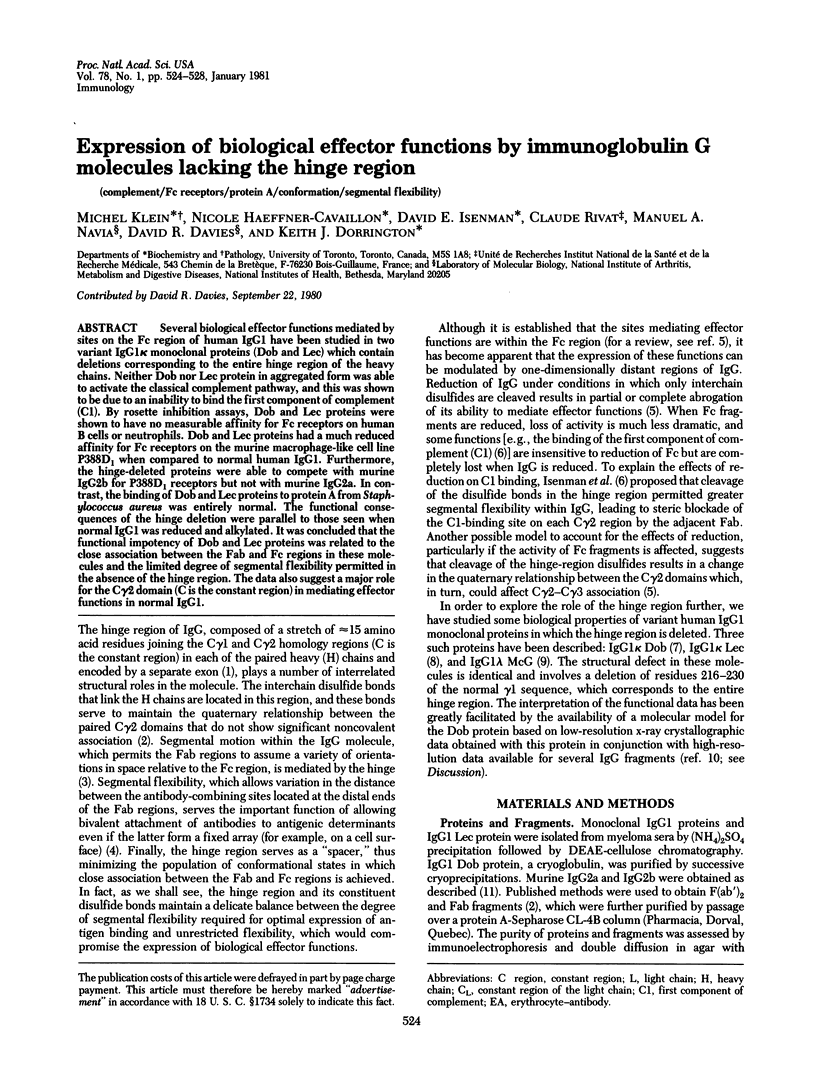
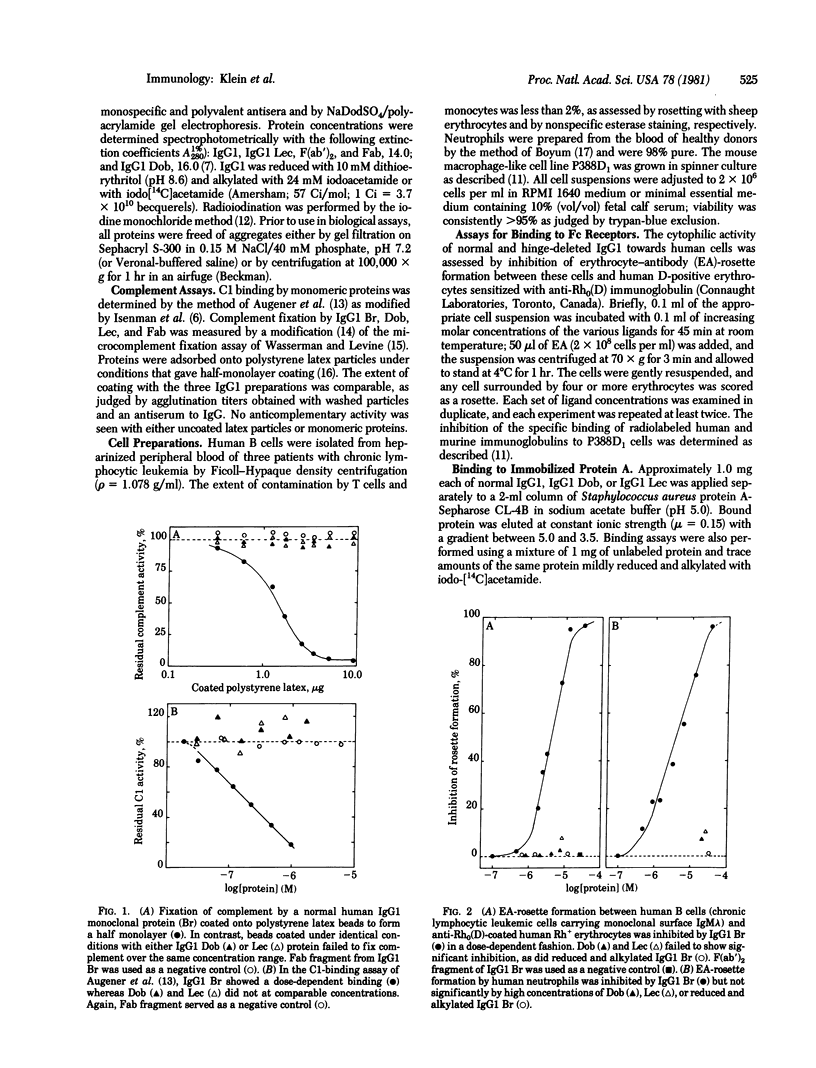
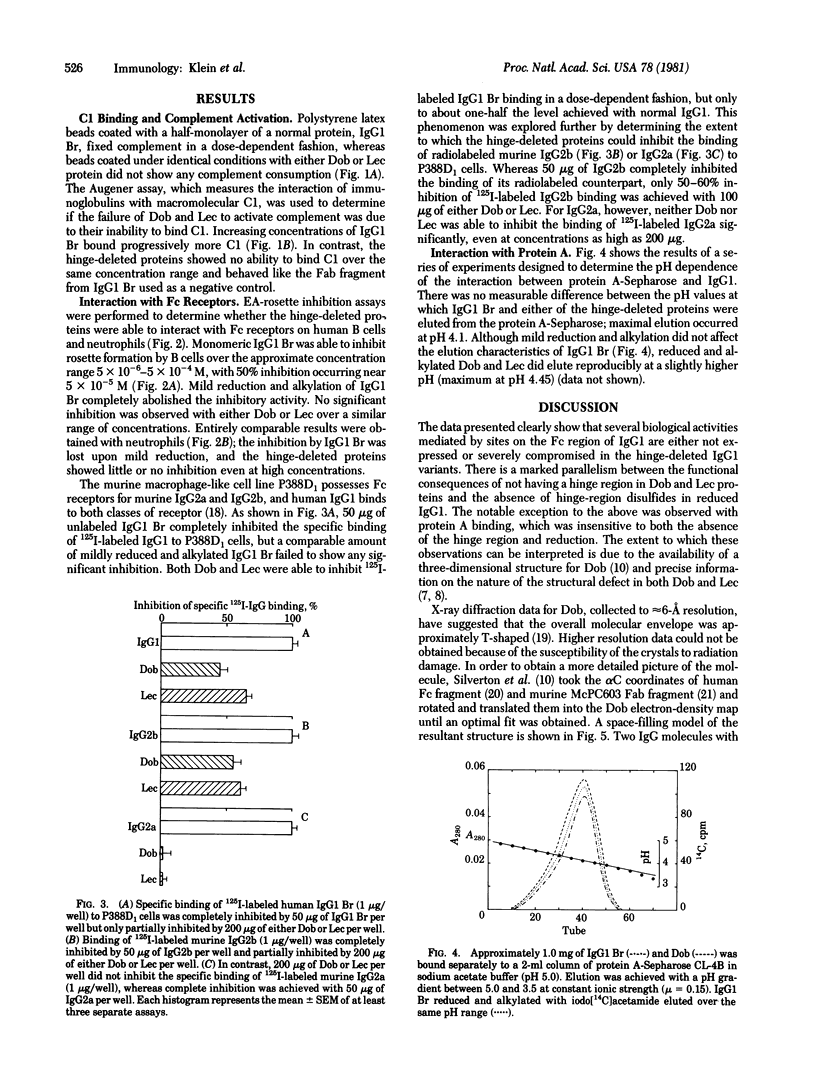
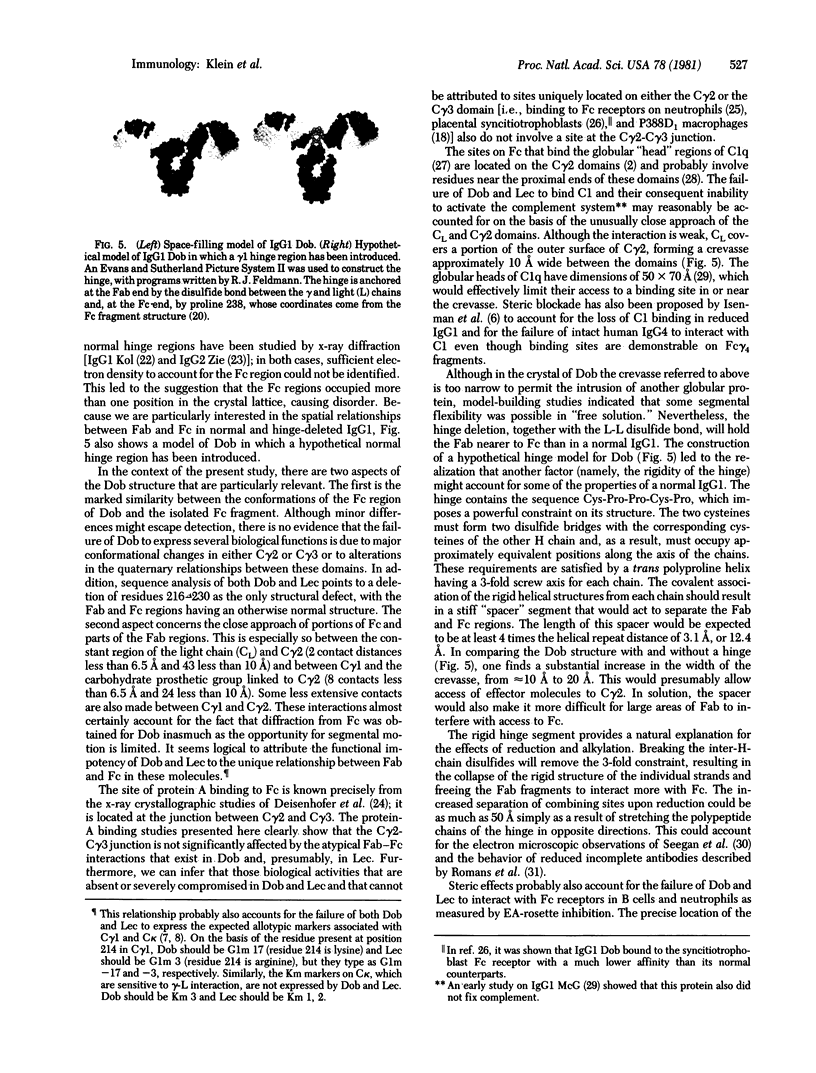
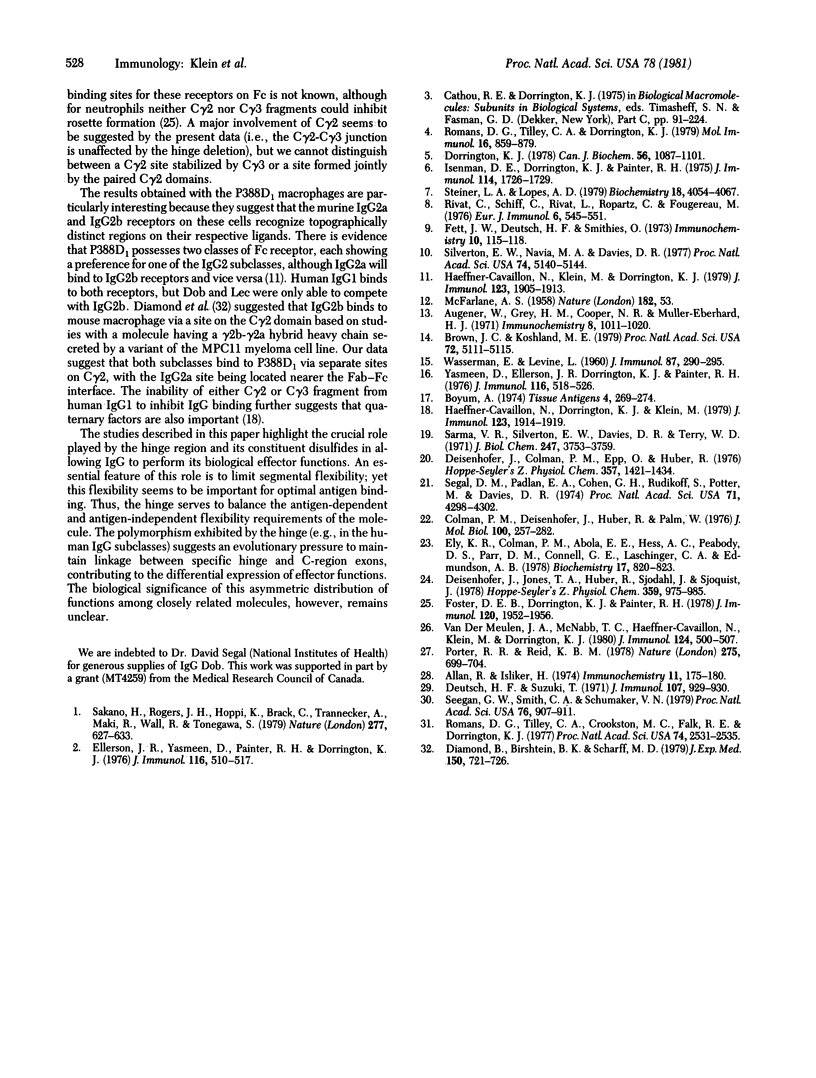
Images in this article
Selected References
These references are in PubMed. This may not be the complete list of references from this article.
- Allan R., Isliker H. Studies on the complement-binding site of rabbit immunoglobulin G. I. Modification of tryptophan residues and their role in anticomplementary activity of rabbit IgG. Immunochemistry. 1974 Apr;11(4):175–180. doi: 10.1016/0019-2791(74)90325-5. [DOI] [PubMed] [Google Scholar]
- Augener W., Grey H. M., Cooper N. R., Müller-Eberhard H. J. The reaction of monomeric and aggregated immunoglobulins with C1. Immunochemistry. 1971 Nov;8(11):1011–1020. doi: 10.1016/0019-2791(71)90489-7. [DOI] [PubMed] [Google Scholar]
- Barnett Foster D. E., Dorrington K. J., Painter R. H. Structure and function of immunoglobulin domains. VII. Studies on the structural requirements of human immunoglobulin G for granulocyte binding. J Immunol. 1978 Jun;120(6):1952–1956. [PubMed] [Google Scholar]
- Boyum A. Separation of blood leucocytes, granulocytes and lymphocytes. Tissue Antigens. 1974;4(4):269–274. [PubMed] [Google Scholar]
- Brown J. C., Koshland M. E. Activation of antibody Fc function by antigen-induced conformational changes. Proc Natl Acad Sci U S A. 1975 Dec;72(12):5111–5115. doi: 10.1073/pnas.72.12.5111. [DOI] [PMC free article] [PubMed] [Google Scholar]
- Colman P. M., Deisenhofer J., Huber R. Structure of the human antibody molecule Kol (immunoglobulin G1): an electron density map at 5 A resolution. J Mol Biol. 1976 Jan 25;100(3):257–278. doi: 10.1016/s0022-2836(76)80062-9. [DOI] [PubMed] [Google Scholar]
- Deisenhofer J., Colman P. M., Epp O., Huber R. Crystallographic structural studies of a human Fc fragment. II. A complete model based on a Fourier map at 3.5 A resolution. Hoppe Seylers Z Physiol Chem. 1976 Dec;357(10):1421–1434. doi: 10.1515/bchm2.1976.357.2.1421. [DOI] [PubMed] [Google Scholar]
- Deisenhofer J., Jones T. A., Huber R., Sjödahl J., Sjöquist J. Crystallization, crystal structure analysis and atomic model of the complex formed by a human Fc fragment and fragment B of protein A from Staphylococcus aureus. Hoppe Seylers Z Physiol Chem. 1978 Aug;359(8):975–985. doi: 10.1515/bchm2.1978.359.2.975. [DOI] [PubMed] [Google Scholar]
- Diamond B., Birshtein B. K., Scharff M. D. Site of binding of mouse IgG2b to the Fc receptor on mouse macrophages. J Exp Med. 1979 Sep 19;150(3):721–726. doi: 10.1084/jem.150.3.721. [DOI] [PMC free article] [PubMed] [Google Scholar]
- Dorrington K. J. The structural basis for the functional versatility of immunoglobulin G1. Can J Biochem. 1978 Dec;56(12):1087–1101. doi: 10.1139/o78-172. [DOI] [PubMed] [Google Scholar]
- Ellerson J. R., Yasmeen D., Painter R. H., Dorrington K. J. Structure and function of immunoglobulin domains. III. Isolation and characterization of a fragment corresponding to the Cgamma2 homology region of human immunoglobin G1. J Immunol. 1976 Feb;116(2):510–517. [PubMed] [Google Scholar]
- Ely K. R., Colman P. M., Abola E. E., Hess A. C., Peabody D. S., Parr D. M., Connell G. E., Laschinger C. A., Edmundson A. B. Mobile Fc region in the Zie IgG2 cryoglobulin: comparison of crystals of the F(ab')2 fragment and the intact immunoglobulin. Biochemistry. 1978 Mar 7;17(5):820–823. doi: 10.1021/bi00598a011. [DOI] [PubMed] [Google Scholar]
- Fett J. W., Deutsch H. F., Smithies O. Hinge-region deletion localized in the IgG-globulin Mcg. Immunochemistry. 1973 Feb;10(2):115–118. doi: 10.1016/0019-2791(73)90238-3. [DOI] [PubMed] [Google Scholar]
- Haeffner-Cavaillon N., Dorrington K. J., Klein M. Studies on the Fc gamma receptor of the murine macrophage-like cell line P388D1. II. Binding of human IgG subclass proteins and their proteolytic fragments. J Immunol. 1979 Nov;123(5):1914–1919. [PubMed] [Google Scholar]
- Haeffner-Cavaillon N., Klein M., Dorrington K. J. Studies on the Fc gamma receptor of the murine macrophage-like cell line P388D1. I. The binding of homologous and heterologous immunoglobulin G1. J Immunol. 1979 Nov;123(5):1905–1913. [PubMed] [Google Scholar]
- Isenman D. E., Dorrington K. J., Painter R. H. The structure and function of immunoglobulin domains. II. The importance of interchain disulfide bonds and the possible role of molecular flexibility in the interaction between immunoglobulin G and complement. J Immunol. 1975 Jun;114(6):1726–1729. [PubMed] [Google Scholar]
- McFARLANE A. S. Efficient trace-labelling of proteins with iodine. Nature. 1958 Jul 5;182(4627):53–53. doi: 10.1038/182053a0. [DOI] [PubMed] [Google Scholar]
- Porter R. R., Reid K. B. The biochemistry of complement. Nature. 1978 Oct 26;275(5682):699–704. doi: 10.1038/275699a0. [DOI] [PubMed] [Google Scholar]
- Rivat C., Schiff C., Rivat L., Ropartz C., Fougereau M. Deletion of hinge region of human myeloma IgG1 molecule (protein LEC) associated with nonexpression of G1m (3) and Km (1, 2) allotypes. A possible genetic explanation at the DNA level. Eur J Immunol. 1976 Aug;6(8):545–551. doi: 10.1002/eji.1830060804. [DOI] [PubMed] [Google Scholar]
- Romans D. G., Tilley C. A., Crookston M. C., Falk R. E., Dorrington K. J. Conversion of incomplete antibodies to direct agglutinins by mild reduction: evidence for segmental flexibility within the Fc fragment of immunoglobulin G. Proc Natl Acad Sci U S A. 1977 Jun;74(6):2531–2535. doi: 10.1073/pnas.74.6.2531. [DOI] [PMC free article] [PubMed] [Google Scholar]
- Romans D. G., Tilley C. A., Dorrington K. J. Interactions between Fab and Fc regions in liganded immunoglobulin G. Mol Immunol. 1979 Nov;16(11):859–879. doi: 10.1016/0161-5890(79)90085-3. [DOI] [PubMed] [Google Scholar]
- Sakano H., Rogers J. H., Hüppi K., Brack C., Traunecker A., Maki R., Wall R., Tonegawa S. Domains and the hinge region of an immunoglobulin heavy chain are encoded in separate DNA segments. Nature. 1979 Feb 22;277(5698):627–633. doi: 10.1038/277627a0. [DOI] [PubMed] [Google Scholar]
- Sarma V. R., Silverton E. W., Davies D. R., Terry W. D. The three-dimensional structure at 6 A resolution of a human gamma Gl immunoglobulin molecule. J Biol Chem. 1971 Jun 10;246(11):3753–3759. [PubMed] [Google Scholar]
- Seegan G. W., Smith C. A., Schumaker V. N. Changes in quaternary structure of IgG upon reduction of the interheavy-chain disulfide bond. Proc Natl Acad Sci U S A. 1979 Feb;76(2):907–911. doi: 10.1073/pnas.76.2.907. [DOI] [PMC free article] [PubMed] [Google Scholar]
- Segal D. M., Padlan E. A., Cohen G. H., Rudikoff S., Potter M., Davies D. R. The three-dimensional structure of a phosphorylcholine-binding mouse immunoglobulin Fab and the nature of the antigen binding site. Proc Natl Acad Sci U S A. 1974 Nov;71(11):4298–4302. doi: 10.1073/pnas.71.11.4298. [DOI] [PMC free article] [PubMed] [Google Scholar]
- Silverton E. W., Navia M. A., Davies D. R. Three-dimensional structure of an intact human immunoglobulin. Proc Natl Acad Sci U S A. 1977 Nov;74(11):5140–5144. doi: 10.1073/pnas.74.11.5140. [DOI] [PMC free article] [PubMed] [Google Scholar]
- Steiner L. A., Lopes A. D. The crystallizable human myeloma protein Dob has a hinge-region deletion. Biochemistry. 1979 Sep 18;18(19):4054–4067. doi: 10.1021/bi00586a002. [DOI] [PubMed] [Google Scholar]
- WASSERMAN E., LEVINE L. Quantitative micro-complement fixation and its use in the study of antigenic structure by specific antigen-antibody inhibition. J Immunol. 1961 Sep;87:290–295. [PubMed] [Google Scholar]
- Yasmeen D., Ellerson J. R., Dorrington K. J., Painter R. H. The structure and function of immunoglobulin domains. IV. The distribution of some effector functions among the Cgamma2 and Cgamma3 homology regions of human immunoglobulin G1. J Immunol. 1976 Feb;116(2):518–526. [PubMed] [Google Scholar]
- van der Meulen J. A., McNabb T. C., Haeffner-Cavaillon N., Klein M., Dorrington K. J. The Fc gamma receptor on human placental plasma membrane. I. Studies on the binding of homologous and heterologous immunoglobulin G1. J Immunol. 1980 Feb;124(2):500–507. [PubMed] [Google Scholar]



